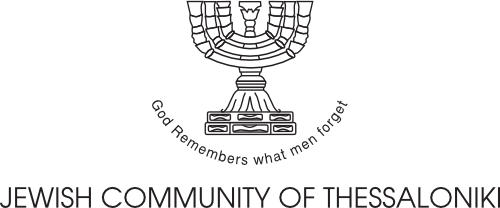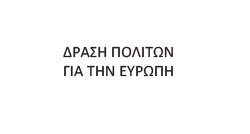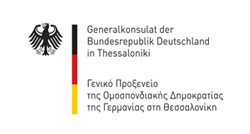“Children and everyday life in the Second World War„
Introduction
This unit focuses on the daily lives of children and people who stood up against the German Occupation through sport and art during World War II in Greece. The cited material includes films, excerpts from literary books, photographs, artwork and information from the internet, through which unfold the tragic living conditions of the people who faced hunger, death and trauma caused by war on a daily basis. At the same time, however, we see the incredible persistence of children and adults in order to survive but also their mental strength struggling daily for freedom with humour, solidarity, art and ingenuity.
We should mention that the Greek version of this unit also presents abundant material on the fighters of the Resistance, who sacrificed themselves for a better future, as well as material for the important historical events of World War II with the aim of using them in the context of planning and organising the school celebration for the national commemoration day of October 28, 1940.
Main Body
Children and war
The very announcement of war signalled a traumatic change in children's souls but also in the daily life of civilians. From one day to the other people lost their freedom and had to adapt to the new adverse conditions outlined eloquently in the following young adults novel.
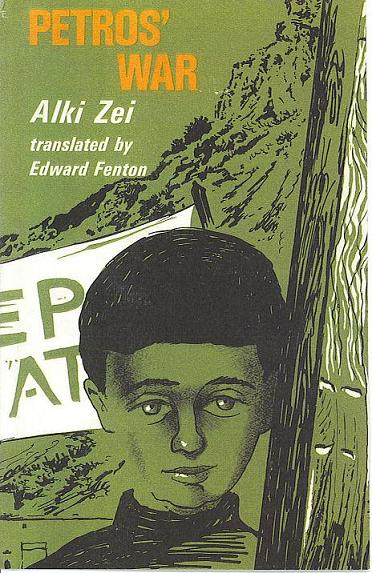
Alki Zei (2011). Petros' War. Athens: Routledge. Source
Book summary
October 27, 1940: Petros will remember this day because it is the day his cricket died. He will remember it because the next day he hears his mother’s voice saying: "Get up... there is war. Haven’t you heard the sirens? "When the Italians arrived on the borders of Greece, Petros was nine years old, he had a pet turtle and he knew war only through books. Now he experiences it each day, along with his parents, his grandfather and his older sister, Antigone, through a long path - a path through Athens during the Occupation, in those difficult years of starvation, soup kitchens, fear, persecution. Guided by his favourite heroes from Greek history and with his adolescence imminent, Peter, with his sister and his friends, does not hesitate to take part in the Resistance, with a song as his moto: Always ahead of us, for a new life...
Information about the book that was published in English
Alki Zei
http://www.alkizei.com/en/press/117-
In 1972, the book was published in English (USA and UK), under the title Petros' War (War of Peter), translated by the American philhellene Edward Fenton (1918-1996). The English version of the novel was awarded the Mildred L. Batchelder Award of the American Association for Library Service to Children organization (ALSC) in 1974. In 1976, the book was published in French, followed by translations in ten other languages.
wikipedia
Starvation and poverty
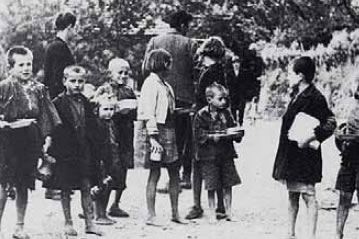
Raggedy and starved children queuing at a soup kitchen during the Occupation
Source: Modern History course book for the last grade of lower secondary education, School book

“Hunger”, by the painter and fighter Alexandros Alexandrakis Source: ipaideia
One of the greatest problems civilians and children faced in their daily life was the lack of food. The problem was greater in cities than in the countryside. Thousands of people died of hunger during the harsh winter of 1941-1942. In the following literary passage, young Petrakis refuses to sacrifice his dog Oscar. As a result, his father, Mr. Laurentis and his sister Paula find him dead in the street.
Mr. Laurentis had lost a leg from frostbite in the mountains of Pindos. He fought to keep the Italians from entering Greece.
"He's a hero who is now starving, along with his entire family", father explained.
Paula came along, crying. Her tears defied the cold and wouldn’t freeze. They both knelt near Petrakis and Oscar and wept as they dug up the snow.
"I told my son we should eat Oscar. Perhaps that would have saved him from scurvy and pellagra. But Petrakis preferred to feed his dog and starve himself. He would give him the soup from the soup kitchen. In the end, they both perished”.
Helen Priovolou (2010). Choco Bloc. Athens: Kastaniotis 10
Children who joined the Resistance
a) Aetopoula and the young of EPON *
Many young children and teenagers were organized and acted with the courage of an adult and at the same time with the awe of a child for freedom and Resistance to the enemy.
In the literary passage which follows a group of Aetopoula** in the district Atlas in Thymarakia organize the week's missions under the guidance of older children, members of EPON. The missions included: transferring messages to the guerrilla fighters and writing slogans for freedom on the walls. The children's activity is characterised by great creativity in their effort to convey messages to the world and to boost morale.
A moment of freedom!
That same night, to honour the new members, we would take to the streets to paint the new clocks: "A moment of freedom!"
-Alright with the clocks, Vangos said.
-I thought of something else, it would be nice if we could make it.
-What is it? Rinoula wanted to know (Oh right! Now we must distinguish between the two, so as not to confuse them. Rinoula the Black).
-To put up a neon sign.
-A neon sign?
The children had seen a couple of such bright signs, put up by members of the EPON.
-It will be hard... Fotakis muttered.
-Hard? It's not at all hard! All we need is globes and batteries and we can do it.
-Sure, but where will we find cardboard?
-An old box.
-From cigarettes! Lefteris laughed.
-No, something bigger, Vangos replied, not minding Lefteris joke.
-There are some big boxes from the Red Cross, where they bring food for the soup kitchen.
-He is right! cried Michael.
-Those are large boxes that we can use.
-And how can we light up the letters? inquired Rinoula the Blonde.
-We will cut out the letters and add globes!
It was a carton of about half a meter. What could they write on it, with large letters, no less? What else? Three letters! The three letters, as the song goes, "which illuminate our generation".
George carved them, Lefteris cut them out so they created a "gap" on the surface of the carton. They put the globes in and connected them to two batteries so they would shine brighter and longer. They shut the windows to keep the light inside and lit them to make a test. Lit from within, the three "hollow" letters shone: EAM***!
-Let's add coloured film! clapped joyfully Rinoula the Dark - sorry, the Black.
They found a sheet of film which George painted a pale green.
They decided to put it in one of the "crenulations" of the Lighthouse, the building looming over Thiras and Acharnon streets.
-They will see it and take it down immediately, sighed Fotakis.
And he was right. How long would it last? One hour, two?
-If only we could plant a mine! Michael was inconsolable.
-Yeah right! Plant a mine! And if some innocent passer-by approaches... Lefteris didn't finish his phrase, but it was clear what he meant.
-Wait, wait! I have an idea! cried Rinoula.
And it really was a very good idea. She suggested that they put up a sign: "Warning! Mines!" even though there wouldn't be any.
Slowly Rinoula's plan was enhanced. They decided to put up three empty cans tied together by a wire, so that it would appears that the neon sign was "dangerous." Who would approach if they saw the cans? The plan was completed with another suggestion by Fotakis: Putting up a sign that read: "Warning! Mines! Patriots, do not touch it! Fascists, please touch the wire... and blow up in pieces! "
So they did. At dusk, Lefteris slipped inside the Lighthouse and placed the neon sign in one of the crenulations.
The entire neighbourhood lit up! The slogan could be seen from afar, an all sides!
People would see it and admire it.
Some constables arrived at once and one of them climbed on the roof of the Lighthouse to take down the sign. But he climbed down just as quickly, terrified.
-There's mines! Stay away!
The children were secretly laughing, hiding among the by-standers. They, too, were admiring their work.
-Let's call for the Engineering specialists to neutralise it! said a sergeant.
Night had fallen by the time they got word to the specialists. It was long hours until they arrived. The sign stayed there throughout the night, allowing the people another breath of freedom!
Dimitris Ravanis-Rentis, (2012). Children of Athens. Novel about the Resistance.
Athens: Modern Times, 72-74.
* EPON: United Panhellenic Organization of Youth. It was a breakthrough as it ranked thousands of teenagers and young people fighting for national liberation and actively participating in the National Resistance. EPON was founded on February 23, 1943 at a secret meeting of representatives of youth organisations of the time. EPON, shortly after its foundation, became the most important and largest youth organization that was active during the Occupation, as well as the most massive youth organization based on voluntary membership that has ever existed in Greece, with an extensive network of local subgroups - covering not only the big cities but also most of the Greek countryside - and significant involvement in the armed Resistance in the ranks of the Greek People's Liberation Army (ELAS).
ELAS: The Greek People's Liberation Army (ELAS) represented the military wing of EAM during the triple occupation of Greece. It was founded on February 16, 1942. It consisted, in essence, of a guerrilla army of volunteers. One of its most prominent personalities was Aris Velouchiotis (Thanassis Klaras), military leader of the greatest and most massive Resistance organization in Greece, during World War II.
** Aetopoulo: young child, working for the Resistance. The Aetopoula acted under the supervision of members of the EPON.
*** EAM: The National Liberation Front (EAM) was founded on September 27, 1941 in Athens, by initiative of the Greek Communist Party (KKE) and with the participation of three other parties, the Socialist Party of Greece (ATC), the Farmers Party of Greece (ACP) and the Union of People's Democracy (ELD). Its goal was the liberation of Greece, the freedom of the people to choose the form of government and the cooperation with other peoples against the Occupying forces. It represented the political face of the Resistance.
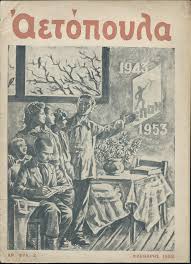
Source: neolaia
b) Saltadori
Saltadori formed a special case. They were children and adolescents who managed to survive and to "fight" in their own creative ways. They were called so because their method was to jump (saltaro) on the cars of the Germans and steal cans of petrol, tires, food and weapons, thus helping those in need but also Resistance fighters in the struggle against the Occupying forces.
The award-winning film "The barefoot Battalion" by Gregory Tallas featured orphans from the orphanages of Athens and Thessaloniki. This is the true story of children who created a gang of saltadori.
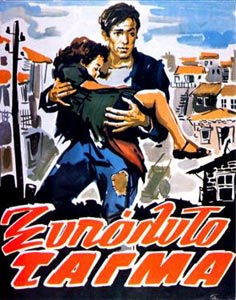
The story of the film
In post war Thessaloniki, a young man, Dimitri, "catches" a kid, Stavros, who has stolen a purse and tells him his story, the history of 160 children who formed the "Barefoot Battalion", struggling to survive during the Occupation. Risking their lives, kicked out of the orphanage, they had created a heroic gang and stole food and medicine from the Germans and their collaborators, which they handed out to those who were in need. As a matter of fact, their relations with a Greek interpreter working for the Germans allowed them to help an officer of the allies flee to the Middle East. A few tins of oil stolen from a black marketeer nearly led to their arrest and execution by the Germans. In the end, after hearing the story, the kid follows Dimitri to the orphanage and decides to stay there in order to find permanent food and shelter and to grow up as an honest man.
Watch the movie with English subtitles here
Information about the film in English: IMDb TCM New York Times
The resourcefulness of saltadori in order to make life difficult for Germans and Italians was unprecedented! In this passage from the autobiographical book "The saltadori of Byron, Personal accounts" Xenophon Filleris narrates:
Bugs
During the outburst of lice not even the Germans were safe! Us, saltadori, would make sure of it! In other words, we'd snatch a louse from our armpit and throw it on a German, just like Zorro with his lasso!
That was a piece of cake for us. We wouldn't let any German or Italian be, we'd make their lives miserable. Of course, these "gentlemen" has soap and lice dust so they could easily get rid of these bugs.
Xenophon Fileris (2005). The saltadori of Byron. Personal accounts.
Athens: Kastaniotis, 53 / 92-93.
But gangs of saltadori were not always successful. Filmmaker Stephen Gekas presents in his short film "THE SALTADORI" the true story of a child who was harshly punished when he tried to steal food for his beloved.
Watch the movie here
Watch here the educational video (available subtitles)
The women
They participated in the Resistance, carried ammunition, gathered supplies for the winter in the mountains, helped in construction projects (bridges), supported the sick and the children.
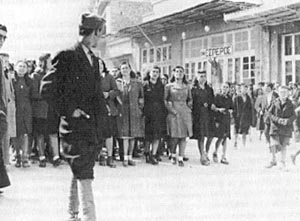
Young demonstrators take to the streets of Yiannena, defying occupation authorities. Athens, Archive of Kostas Balafas © Kostas Balafas
Source: ime
A wall of the living
The victors of Pindos were moving forward. When they reached the river Vogiousa and the fearless women of Pindos saw that the strong current hindered the work of the diggers, they spontaneously acted the way other women would later in Kalamas and Drinos: they entered the water, holding each other by the shoulders, and created a barrier that broke the current of the river and allowed the men to build the bridge!
Source: ime.gr
Women of the 1941-44 Greek Resistance against the Axis: An Historical and Sociological Perspective
Athletes
They would organise matches in order to raise money for the soup kitchens. Many athletes would also participate in the Greek Athletes Association and some were executed for their role in the Resistance. Jerzy Iwanow was one of them.
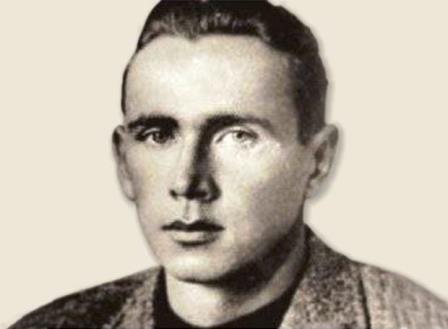
Jerzy Iwanow
Source of the photo: mixanitouxronou
...the acts of resistance of Greek football players and athletes in general was considerable. "Legendary" was the team that Jerzy Iwanow, an athlete with Iraklis in Thessaloniki, and Michalis Papazoglou, a football player of Panathinaikos, had created. This team would pass information about the Germans to the allies and it had even contributed in sabotaging military bases. Iwanow was, after all, the most notorious saboteur during World War II.
Artists
Apart from the members of organisations of the Resistance, members of the artistic community also contributed to the war against the Occupation and in favour of Freedom: they participated in the Resistance, they fought, they entertained the people and gave them courage through their work.
Vaso Katraki, painter
1942-1943: She was a member of the artists' National Liberation Front (ΕΑΜ). The illegal issue "From the fights of the Greek people" was published featuring some of her block prints.
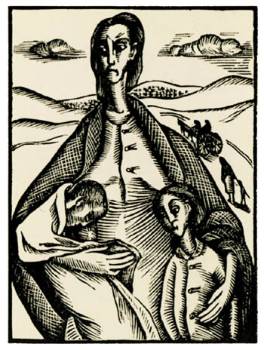
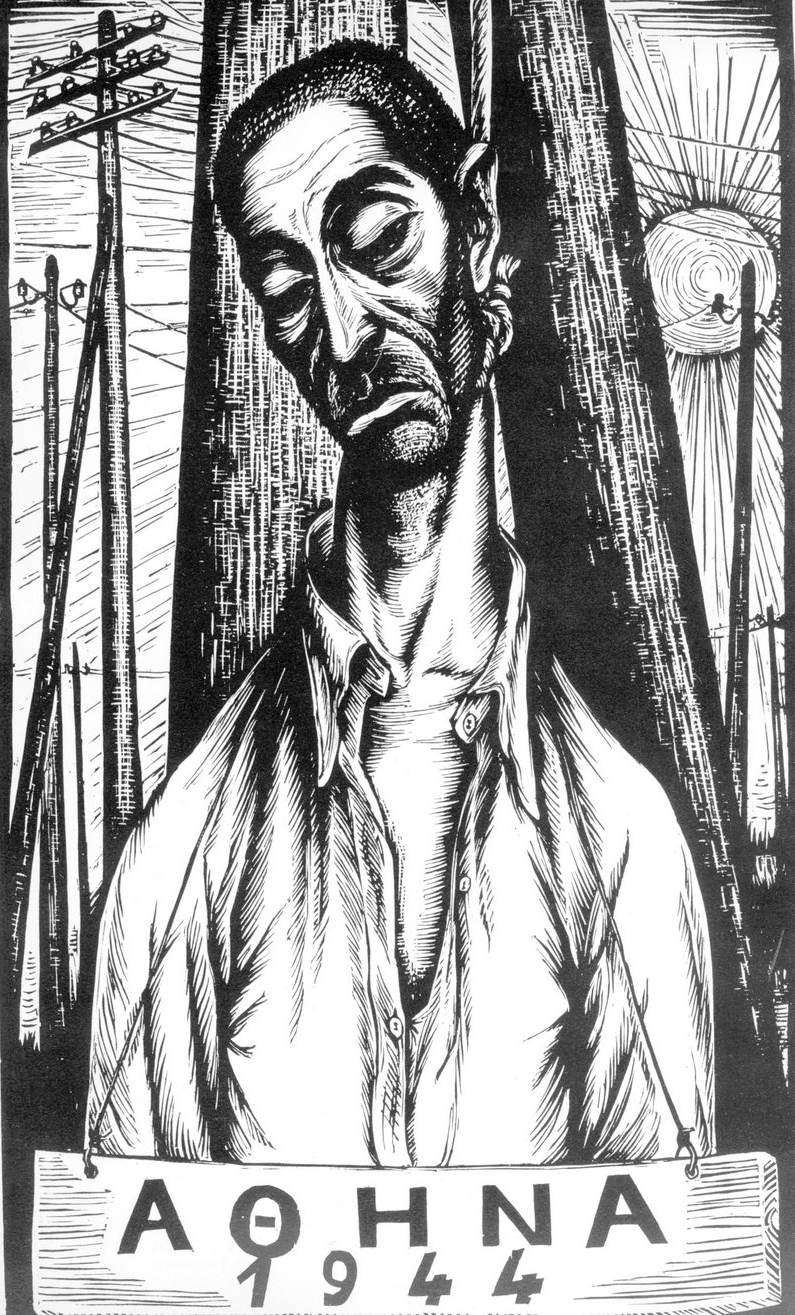
Source: I NEA EPOXI: Athens 1944

Poster: For the soldier - Vassokatraki
Mountain theatre
Mountain theatre presented through improvised shows, which were often written collectively, the life of guerilla fighters. It was presented in schools and squares, and it allowed ordinary people, amateur actors, to express themselves through artistic creation.
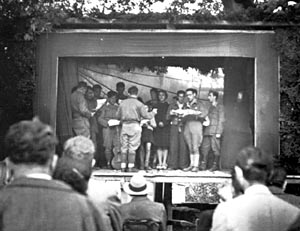
Theatre in free Creece. Sp. Meletzis, In the mountains with guerrilla fighters, Athens 1996, pl 252. ©Spyros Meletzis (Source)
Voula Papaioannou, photographer (in English)
Benaki Museum
Valias Semertzidis, painter (in English)
The National Gallery - Alexandros Soutzos Museum
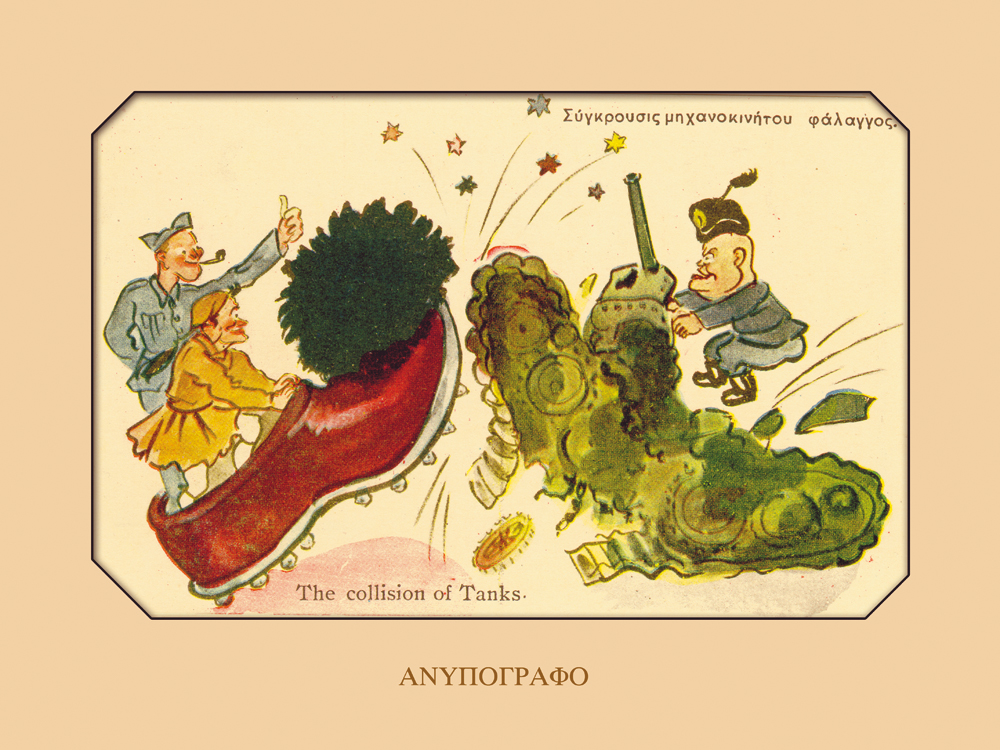
Comic strip dated 1940, Unsigned. (Source)
Further information about this unit:
Foundation of the Hellenic World: The Second World War 1940-1945



